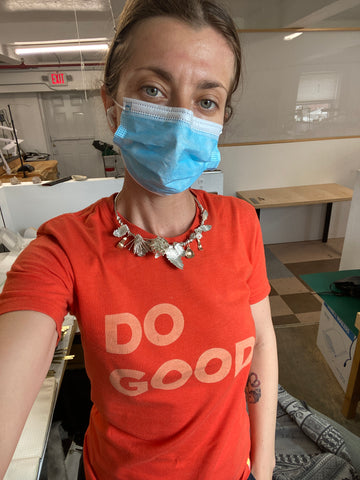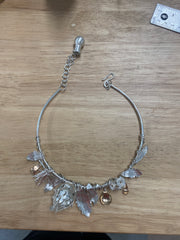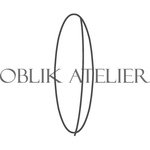Women.
Our Choices, Our Decisions, Our Rights.
It is the 21st century and I am actively engaged in preserving these rights. If someone told me in college I would be grappling with this today, I would've dismissed them. I appreciate having an audience that I can share my efforts with and hopefully encourage you to action and engage.
I made this necklace called "Wise Women", and my dear friend Arnold Ephraums created a beautiful drawing that the necklace rests on, for Plan B Art project. I would like to use this journal entry to tell you more about the process, efforts and thoughts behind it.

Mid June, I was honored to be part of the American Croatian Professional Association conference in NYC, where most of the people and topics were tech and business oriented, but my panel (loosely about fashion) gave me an opportunity to share that I choose jewelry as my form of expression. Not only to create beautiful shapes, but also to reflect on political, social and cultural events that are affecting me and those around me. Afterall, we look to artists from the past and appreciate each of them giving their observations on the current affairs of their time. This is how history was captured. This is how we learned and changed (or so it seemed)
Amanda Gorman says:
"Because when we show up today, we are already standing up for the tomorrow we made"

I am obligated to speak up, engage and contribute and be the POSITIVE CHANGE AGENT.
I came to know about the Plan B Art Project after the first set up at the Monique Rancourt Gallery. and since we started working together, she quickly connected me to the curator and the idea person behind the project, Shauna Burke.
Plan B is a group art project designed to call attention to the current state of a woman's right to make choices for her own body. Art has always been a symbolic tool to bring societal injustices to light, and the Plan B project is a subtle nod to our past and - more disturbingly - the future of a woman’s ability to seek a safe method of ending her pregnancy in this country. For this project, each artist could choose from one of four types of small silver Amphora bottles or create their own interpretation of an amphora form. The Amphora bottle symbolizes vintage pharmaceutical bottles and historical methods used to end pregnancies through abortifacient herbs and poisons.
What immediately sparked my interest were the plants. I grew up in a household where both my grandmother and my mother turned first to the natural world for healing before (and if) resorting to pharmaceuticals. For common cough and cold we used sage tea for rinsing, for bladder issues tea made of Uva Ursi, to name a few. Even though I was 17 when I left Croatia, this is something that I have absorbed into my core. Even my husband who is a very practical and pragmatic man has now become an Arnica fan, since it has proven to be the only relief he can have for his injured knee.



Women are intuitive and have looked to nature for millennia. These natural ways were respected remedies for ailments and people looked to women for help and guidance for minor and significant issues. In Middle Ages they called them witches and many women were burned to death for this practice. Today, there are just a few indigenous cultures that still turn to nature as their greatest source for remedies.



In preparation for this project I did some reading and came across THIS ARTICLE by Burkhard Bilger who described his wife and his accidental journey to abortifacients only in recent years. He found a book by Jim Riddle speaking about contraceptives throughout history.
"Silphium was the aristocrat's contraceptive -- the classical equivalent of lambskin condoms. But contraceptives of any kind were beyond the ken of common folk, or so most historians have held. Peasants hardly knew the connection between sex and pregnancy, the reasoning goes, much less which plants might inhibit conception. To counter such arguments. Riddle presents a chart of the declining birthrate in ancient Greece -- from 5.0 births per female in 2000 B.C. to 3.3 in 120 A.D. "How did they do it?" he asks. Infanticide, some historians answer But then why are women's skeletons from ancient sites scarred by so few childbirths? Chastity, one might venture. But sexual restraint, as Riddle writes, "was not a quality about which the ancients could boast or lament."
The best answer seems to be the obvious one: the common folk were not as ignorant as they seemed. For centuries farmers must have noted how plants could affect their pregnant livestock -- according to some estimates nearly a third of all miscarriages among animals are caused by plants. Mothers and midwives must then have passed on the information and refined it in what Riddle calls, with a touch of melodrama, a "chain of learning...forged by vocal cords."



We no longer have that extensive knowledge about the natural world around us. It is dangerous, to say the least. And considering what women did for centuries to protect themselves from unwanted pregnancies it is frightening to think that we would need to turn this way as a last resort because all the inventions of modern medicine are becoming unavailable to us.
When I was in college in Savannah, GA and when I first moved to NYC I did not have health insurance and Planned Parenthood was the place I turned to for annual exams and for contraceptive prescriptions. Most of my friends went there. It was and IS a safe space for women.
This necklace I created supports Planned Parenthood through the Plan B Art Project. The creation process was long, very thoughtful, physically and mentally challenging and as such it draws parallel to what is becoming of our rights.
My friend Arnold drew this striking drawing reflecting some of the flowers and plants I used, as I wanted to have a beautiful and hopeful ground for this idea to rest on. His thoughts on our collaboration:
"We wanted the background of plants used to concoct abortive tonics to frame the necklace, but I wanted it to be more than decorative backdrop. The history of Botanical and Anatomical illustration and their detailed cross sections of plant and human structures fascinated me and it felt natural that they should also inform the structure of this illustration. The plants imply the structure of the female reproductive system and cross sections of plant systems reinforce our connection to nature."
I started the project a couple of months ago and finished it a few days before this constitutional right was taken away.
This necklace is an homage to all the wise women across centuries, their incredible resourcefulness and courage to take care of themselves and one another. When I spoke to Shauna about the project and our impact, we both agreed that we are in it for the long haul. As I think of my friends and their young daughters, my work is for them so they live the freedoms we all deserve as human beings.
I ask you to act in support here and please share the project:
I captured my creative process here in this short video:
My necklace and Arnolds drawing, is traveling to Pistachios Gallery in Chicago in August for the 3rd installation of this show.
Necklace and drawing together are available for purchase through the exhibitions and 25% will be going directly to Planned Parenthood.
Shauna plans to cary the project through 2023 and is looking to partner with galleries and institutions, especially those in states where abortions are being outlawed, to host this exhibit.
Please connect with me if you would like to host the show info@oblik-atelier.com
I appreciate your time and for showing up for all of us in this effort.

1 comment
So touched and proud to be a part of this project and to have been asked by Mia to contribute to this cause which is a fundamental human right.
Arnold Ephraums on